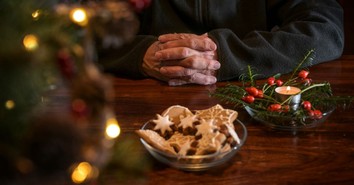The Gospel in Your Oven

Why do the ears of chocolate bunnies taste so much better than the rest of the rabbit? I don’t have an answer for that . . . but I do have some fun facts about Easter foods and even a couple of recipes you can use to share the gospel or as part of your personal devotions. (Bonus: unlike the flannel boards from Vacation Bible School days, these are visual aids you can eat.)
The Easter season has ties to a number of foods and I’m not just talking about candy eggs, jelly beans, and marshmallow chicks. For example, ham is the star of many Easter luncheons. Do you know why? Historically, hogs were slaughtered in the fall and it took pretty much all winter for a ham to cure. Easter rolled around about the time hams were ready to eat, so it was logical to break out the pork to celebrate the season.
But that’s mostly a matter of convenience. Back in the day, some treats were limited to Eastertide by royal decree. Hot cross buns—a spiced, fruity, but not particularly sweet roll with a frosting cross on top—were once considered downright dangerous. This was not because of their ingredients, but due to their ties to Catholicism. This was back in Elizabeth I’s day and it apparently bothered Her Royal Highness so much, the Daily Telegraph tells us, that she issued an edict “forbidding the sale of ‘any spice cakes, buns, biscuits, or other spice bread except it be at burials, on Friday before Easter or at Christmas.’”
(Before you breakfast lovers get into a tizzy over the ban on biscuits, remember that in England “biscuit” means “cookie.” Though now that I think about it, that doesn’t really make it better, does it?)
Elizabeth’s issues aside, custom says that if you share a hot cross bun with someone else, offering it to them with the words "Half for you and half for me, between us two shall goodwill be," you will ensure that friendship will prosper for the coming year. (Regardless of whether or not that’s true, it is always nice to share snacks with your friends.)
Speaking of sharing, here’s one way to share the Easter story through food: Resurrection Rolls. While this may have been designed as an activity for children, I recently made them with a small group of grown women. Not only did the process spark a meaningful discussion about the crucifixion and resurrection, the finished product was delicious.
Resurrection Rolls
Ingredients:
- One can of crescent rolls
- Large marshmallows (one for each roll you’ll be making)
- Butter (about ¼ cup ought to do)
- Cinnamon/sugar mixture (just eyeball it, you don’t have to be precise)
- New Testament
Directions:
- Turn on your oven and start it preheating to 350 degrees. Read John 19. Line a baking sheet (you’ll want one with a rim) or pan with parchment paper. (Wax paper may also work, but not as well.) Melt butter and let cool slightly.
- Unroll the crescent rolls and separate into individual rolls. The rolls represent the cloth they wrapped Jesus’ body in after he died.
- The white, "pure" marshmallows represent Jesus being without sin. Roll each marshmallow in melted butter then in the cinnamon/sugar mixture to symbolize the embalming oils and spices used to anoint Jesus’ body.
- Wrap each marshmallow “body” in a crescent roll dough “cloth,” pinching the edges of the dough together so the marshmallow won’t leak out.
- Put the rolls in the tomb (oven) and bake for 12 minutes. While the rolls are baking, read John 20:1-18.
- Open the tomb and remove the rolls. Once they’re cool enough to handle, break one open to see what happened to the marshmallow inside.
If you like the roll idea but want to dig even deeper into the story, here’s a more detailed Easter cooking project. Note that you’ll need to begin the night before in order for it to work! If you have kids around (or even if you don’t), it’s a fun (and delicious) way to work your way through the Passion story.
Resurrection Cookies
To be made the evening before Easter.
Ingredients:
- 1 cup shelled pecans (whole or halves)
- 1 teaspoon vinegar
- 3 egg whites
- Pinch of salt
- 1 cup sugar
- Zipper baggie
- Wooden spoon(s)
- Wax paper
- Tape
- Bible (Old and New Testaments)
Directions:
- Preheat oven to 300 degrees (This is important. Do it now. Don't wait until you're halfway through the recipe!) Line two cookie sheets with wax paper.
- Place pecans in zipper baggie. Beat them with wooden spoon to break into small pieces. Read John 19:1-3 (the story of Jesus being beaten by the Roman soldiers after his arrest).
- Smell the vinegar. Put 1 tsp. vinegar into mixing bowl. Read John 19:28-30 (Jesus was given vinegar to drink when he was thirsty on the cross).
- Add egg whites to vinegar. (Eggs represent life; Jesus gave his life to give us life). Read John 10:10-11.
- Sprinkle a little salt into your hand. Taste it; brush the rest into the bowl. (Salt represents the salty tears shed by Jesus' followers and the bitterness of our own sin.) Read Luke 23:27.
- Add 1 cup sugar. Psalms 34:8. (The sweet part of the story is that Jesus died because he loves us and he wants us to belong to him.) John 3:16.
- Beat with a mixer on high speed until stiff peaks are formed, 10-15 minutes. Isaiah 1:18. (White represents purity.)
- Fold in broken nuts. Drop by teaspoon onto cookie sheet. Don’t make them too big; aim for about 1” diameter. Matthew 27:57-60 (each mound represents the rocky tomb where Jesus' body was laid).
- Put the cookie sheets in the oven, close the door and turn the oven OFF. Seal the oven door with tape. Read Matthew 27:65-66 (sealing Jesus’ tomb).
- Go to bed! Read John 16:20 and John 16:22. It may be sad to leave the cookies in the oven overnight (especially for young cooks), but Jesus' followers were in despair when the tomb was sealed.
- On Easter morning, read Matthew 28:1-9. Unseal and open the oven and pass out the cookies. Take a bite and you’ll find the cookies are hollow, just like the empty tomb!
More Than a Snack
What I like about these recipes—in addition to the tasty treats they produce—is that working through each step makes me slow down and pay attention to the different parts of the story. I have a bad habit of zipping through familiar stories from Scripture because, after all, I know how it all ends. The time it takes to beat pecans into submission or tenderly tuck marshmallows into their dough burial cloths helps me ponder the journey from Friday through Saturday, rather skipping ahead to the Sunday morning party. Try it and see if your baking project helps make the story come alive for you, too. Happy Easter!

Originally published March 29, 2012.







